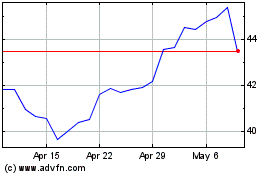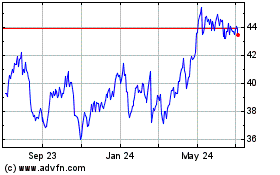* China to Become Second Largest Export
Destination for American Goods by 2030 *
* Industrial Machinery, Transport Equipment,
and Information and Communications Technology Likely to Drive
Nearly Half of all U.S. Trade by 2030 *
* Trade Liberalization Expands Access to Faster
Growing Markets Vital to U.S. *
Trade expansion is expected to boost the American economy,
according to the latest HSBC Global Connections Trade
Forecast. Trade growth contributions to overall GDP are
projected to be driven by increased trade liberalisation and
growing demand to and from emerging and advanced Asian markets.
Trade agreements including the Trans-Pacific Partnership (TPP),
the Transatlantic Trade and Investment Partnership (TTIP), the
Regional Comprehensive Economic Partnership (RCEP) and the WTO
Trade Facilitation Agreement will open markets and have the
potential to eliminate barriers to trade. For businesses this could
mean opportunities for new product development and new trade
partners.
“The dismantling of trade tariffs and removal of other
restrictive barriers to free commerce creates an express lane for
businesses to reach faster-growing markets, underpinning the return
to a more moderate-to-high level growth environment for the U.S.
economy,” said Derrick Ragland, Executive Vice President and Head
of U.S. Middle Market Corporate Banking, HSBC Bank USA, N.A.
Expansion into high growth markets, including China, could mark
an economic boom for American trade. For example, the expansion of
the existing Information Technology Agreement (which includes 75
countries) is projected to increase the value of U.S. exports by
$2.8 billion. It is also expected to boost revenues of U.S.
information and communications technology firms by $10 billion and
support the creation of 60,000 new American jobs (1).
Asian Markets Expected to Dominate U.S Export Demand
In the past three years, exports as a share of U.S. GDP reached
13.5 percent, the highest share since at least 1947 (2). Even as
trade exports grow and liberalization continues, the report finds
that Canada is still expected to remain the top export trade market
for U.S. goods in the medium and long term, due in large part to
its proximity and size. The report projects that by 2030 China will
surpass Mexico as the second largest American export trading
partner, with Mexico dropping into third place. During the same
period Korea is expected to become the fourth largest market for
U.S. exports, followed by Brazil, pushing Japan out of the top
five. In addition, the fastest-growing export markets for American
goods are expected to include China, India, Malaysia and Vietnam,
with growth around nine percent annually.
“Strong economic growth in faster growing Asian economies
represents a major business opportunity for U.S. exporters,” said
Ragland. “It’s up to American businesses to capitalize on this
trend… and every indication is that they will. For example, 7 in 10
U.S. businesses have told HSBC they expect to buy or sell more
goods with China alone in the near-term (3).”
The report also finds that industrial machinery and transport
equipment are expected to remain the major American exports in the
foreseeable future and are expected to contribute about 40 percent
of the projected growth in total exports through 2030. Other
important drivers of exports will include high-value items such as
scientific apparatus, chemicals, and information and communications
technology (ICT) goods, as well as petroleum products and
plastics.
Canada and Mexico Remain the Top Two U.S. Trade Import
Partners
While imports into the U.S. closely mirror that of exports
(industrial machinery and transport equipment), these two
categories together with ICT will collectively account for almost
half of total import growth for the U.S. in the decade leading up
to 2030. Clothing and apparel and petroleum products are expected
to account for around 15 percent of total import growth in this
period. Overall, the strength in these sectors will mainly reflect
solid growth in domestic activity, maintaining the pull for
imports.
The top four largest trade corridors for American imports are
expected to remain unchanged, led by China, Canada, Mexico and
Japan, respectively. Interestingly, the report projects that India
will overtake Germany for the fifth position by 2030. The
fastest-growing countries for U.S. imports over the long term are
projected to be China and Vietnam – with growth at about 9 percent
annually for both countries – and India (up 8 percent) and Mexico
(up 7 percent).
Concluded Ragland, “America’s economic outlook remains firm as
solid job growth, low inflation and strong disposable income growth
all support American household spending. With our highly-educated
labor force, solid institutions, innovative technology and
efficient production processes, the U.S. is well-positioned to
benefit from rising world trade.”
Notes to editors:For updates from the HSBC Press Office,
follow us on Twitter: www.twitter.com/HSBC_Press
About the HSBC Trade Forecast - Modeled by Oxford
EconomicsOxford Economics has tailored a unique service for
HSBC which forecasts bilateral trade for total exports/imports of
goods, based on HSBC’s own analysis and forecasts of the world
economy, to generate a full bilateral set of trade flows for total
imports/exports of goods and balances between 180 pairs of
countries.
Oxford Economics employs a global modeling framework that
ensures full consistency between all economies, in part driven by
trade linkages. The forecasts take into account factors such as the
rate of demand growth in the destination market and the exporter's
competitiveness. Exports, imports and trade balances are
identified, with both historical estimates and forecasts for the
periods 2014-16, 2017-20 and 2021-30. Sectors are classified
according to the UN’s Standard International Trade Classifications
(SITC) and grouped into 30 sector headings. More information about
the sector modeling can be found on
www.globalconnections.hsbc.com
HSBC Commercial BankingFor nearly 150 years we have been
where the growth is, connecting customers to opportunities. Today,
HSBC Commercial Banking serves businesses ranging from small
enterprises to large multinationals in almost 60 developed and
faster-growing markets around the world. Whether it is working
capital, trade finance or payments and cash management solutions,
we provide the tools and expertise that businesses need to thrive.
With a network covering three quarters of global commerce, we make
HSBC the world’s leading international trade and business bank. For
more information see www.hsbc.com/1/2/business-and-commercial
About HSBC Bank USA, N.A.HSBC Bank USA, National
Association (HSBC Bank USA, N.A.), with total assets of US $178.7
billion as of 31 December 2014 (US GAAP), serves 2.4 million
customers through retail banking and wealth management, commercial
banking, private banking, asset management, and global banking and
markets segments. It operates more than 230 bank branches
throughout the United States. There are over 145 in New York as
well as branches in: California; Connecticut; Delaware; Washington,
D.C.; Florida; Maryland; New Jersey; Pennsylvania; Virginia; and
Washington. HSBC Bank USA, N.A. is the principal subsidiary of HSBC
USA Inc., an indirect, wholly-owned subsidiary of HSBC North
America Holdings Inc. HSBC Bank USA, N.A. is a member of the
FDIC.
Sources:(1) Information Technology and Innovation Fund,
http://www2.itif.org/2012-boosting-exports-jobs-expanding-ita.pdf?_ga=1.102254850.2068359215.1432158023(2)
HSBC Report: How America is Made for Trade,
http://cmbinsight.hsbc.com/americamadefortrade(3) HSBC Report: RMB
Internationalization Study 2015
View source
version on businesswire.com: http://www.businesswire.com/news/home/20150528006086/en/
Media inquiries:HSBCNhan
Chiem, +1 212-525-7287nhan.chiem@us.hsbc.com
HSBC (NYSE:HSBC)
Historical Stock Chart
From Mar 2024 to Apr 2024

HSBC (NYSE:HSBC)
Historical Stock Chart
From Apr 2023 to Apr 2024
